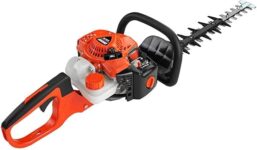
Echo vs Husqvarna Hedge Trimmer – 21.2cc vs 21.7cc: How They Perform
They ask whether the Husqvarna’s 0.5cc edge justifies a higher price—or if the Echo vs Husqvarna hedge trimmer comparison shows Echo’s lighter feel and surprising torque makes it the smarter buy.
Echo 21.2cc and Husqvarna 21.7cc face off in a concise, hands-on comparison that examines real-world performance, handling, noise, and value, helping readers decide which hedge trimmer fits their yard chores without fluff, with brief verdicts for owners and pros alike.
Lightweight Precision
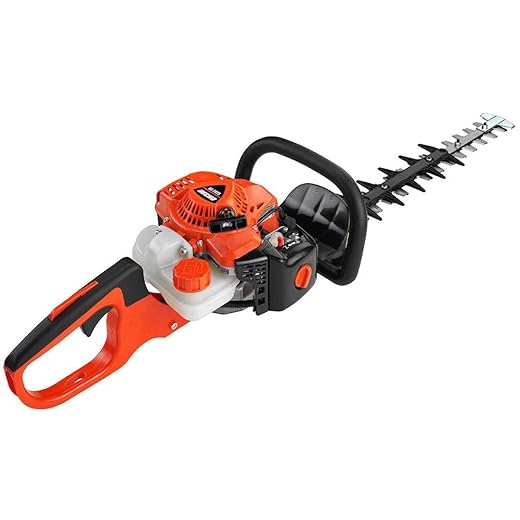
A compact, well-balanced gas hedge trimmer that suits homeowners and light pro work. It prioritizes ease of use and clean cutting over brute force, making it a strong choice for routine hedge maintenance.
Professional Power

A more powerful, pro-oriented hedge trimmer built to move through dense growth quickly. It trades a bit of maneuverability and lightness for longer reach, greater cutting capacity, and robust components suited to heavier residential or part-time professional use.
Echo HC-2020
Husqvarna 322HD60
Echo HC-2020
Husqvarna 322HD60
Echo HC-2020
Husqvarna 322HD60
Echo CS590 vs Husqvarna 562xp: How Close Is the Performance?
Design, Build Quality, and Ergonomics
This section inspects how each trimmer is built and how it feels in hand. It compares materials, overall weight and balance, shaft and handle geometry, grip comfort, blade length (20″ Echo vs. 24″ Husqvarna), protective guards, and vibration-damping systems. It notes serviceability—access to spark plug, air filter and carburetor—for users who plan routine maintenance. The analysis highlights which tool feels more solid for long sessions and which offers the lighter, more maneuverable package for detailed shaping.
Materials, weight, and overall feel
Echo favors a lighter, compact chassis with a 20″ double-sided blade that makes it feel nimbler during detail work and tight turns. Husqvarna uses heavier-duty alloy components and a 24″ hardened-steel blade that delivers a more substantial, professional feel—better for long runs of thick hedging but slightly more arm fatigue.
Shaft, handles, and balance
Echo’s straight shaft and slim rear handle emphasize maneuverability and quick wrist movement for shaping. Husqvarna adds a multi-position rear handle and a slightly longer body to improve reach and leverage when cutting tops and tall hedges.
Blade length, guards, and cutting reach
Vibration control and serviceability
Echo includes user-friendly service points—tool-less air filter cover and a zero-type grease fitting—so routine maintenance is quicker. Husqvarna prioritizes a durable gearbox and professional-grade blade materials; its service access is solid but typically requires basic tools for filter and spark-plug work.
Which feels better for long sessions vs. detailed work
For extended, heavy-duty trimming the Husqvarna’s build and 24″ cutter rule; for lighter shaping, tighter spaces, and less wrist fatigue, Echo’s lighter, more maneuverable package is the smarter choice.
Performance: Power, Cutting Efficiency, and Runtime
Engine output, throttle response, and torque under load
Both machines use small two‑stroke engines in the same class: Echo at 21.2 cc and Husqvarna at 21.7 cc. The extra 0.5 cc on paper gives the Husqvarna a slight edge in mid‑range torque; it feels stronger when pushing through dense growth. Echo’s 21.2 cc delivers crisp throttle response and a predictable rev curve, so it accelerates cleanly from idle to cut speed without hunting.
Cutting efficiency and finish quality
Blade length and tooth spacing drive throughput more than the tiny cc difference.
Fuel consumption and real‑world runtime
Both use similar two‑stroke fuel mixes and consume fuel at comparable rates typical for 21cc class trimmers. Expect roughly 45–75 minutes of intermittent, mixed‑hedge use on a full tank depending on throttle habits and cutting density — heavy continuous cutting drops runtime toward the lower end. Echo’s slightly lighter build translates to marginally longer user endurance per tank because the operator tires less quickly.
Hot‑cutting (thicker branches) and stall behavior
Husqvarna handles thicker stems (manufacturer rates up to ~4/5″) with fewer jams and less bogging; its gearbox and blade momentum keep cuts moving. Echo will cut small to moderate shoots cleanly but can bind or slow on sap‑heavy, larger branches; repeated hot cuts require blade cleaning and slower feed rates on Echo. Neither is intended to replace a pruning saw for branches over about 3/4″.
Practical takeaway
Usability: Startability, Noise, Vibration, and Maintenance
Startability and tuning
Both machines use conventional two‑stroke starting systems; Echo’s HC‑2020 leans on a proven, easy‑to‑pull setup and gets credit for “reliable starting” in the field. The Husqvarna 322HD60 is generally straightforward but has a few owner reports of stubborn cold starts or occasional throttle hesitation. In practice:
Noise, vibration, and fatigue
Both are noisy compared with electric models; hearing protection is mandatory. Vibration levels differ:
Maintenance and parts
Routine care is straightforward for both; Echo’s tool‑less air‑filter cover and zero‑grease fitting lower friction for casual users. Husqvarna’s robust gearbox and hardened blades need less frequent edge work but can be pricier to service. Typical tasks:
Safety, Features, Warranty, and Value
Safety features
Both machines use the standard dual‑switch (dead‑man) control to prevent accidental run‑on and have double‑sided blades that require careful handling. Notable differences:
Included accessories and convenience
Warranty and dealer/service network
Echo typically backs residential handhelds with a multi‑year consumer warranty and wide dealer support; parts tend to be cheaper and commonly stocked. Husqvarna offers a multi‑year residential warranty as well (check current terms) and an extensive service network geared toward pros—parts and labour costs are higher, but service centres are widespread.
Price, Amazon deals, and long‑term costs
Price on Amazon: Echo ≈ $349, Husqvarna ≈ $449. Sales commonly reduce either model by $30–$100 during peak seasons. Long‑term ownership:
Value scores (practical buyers)
Feature Comparison
Final Verdict: Which to Choose
They are two strong trimmers: the Echo favors lighter weight and nimble handling for ornamental trimming, while the Husqvarna’s longer blade and slightly higher displacement make it better for larger hedges and fewer passes. For most homeowners the Husqvarna is the clear overall pick for efficiency and reach; the Echo wins for users prioritizing control and reduced fatigue.
They should pick Husqvarna for big hedges and fewer passes; they should pick Echo for lightweight precision.



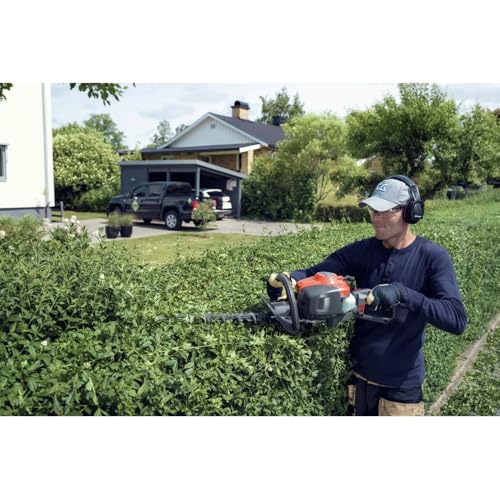

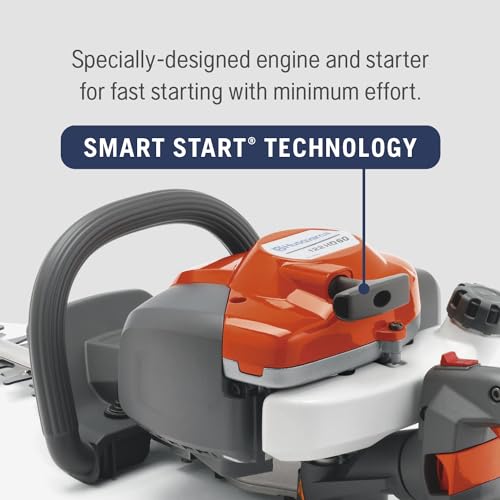
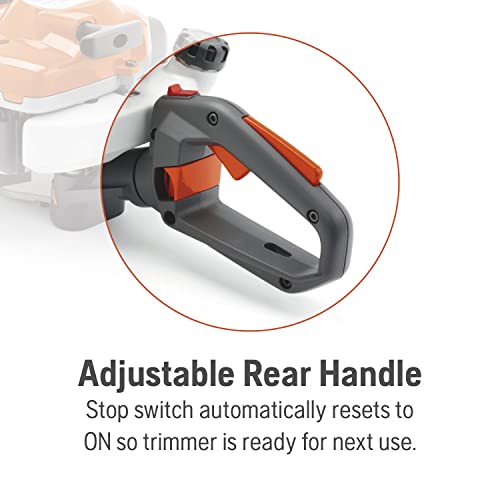


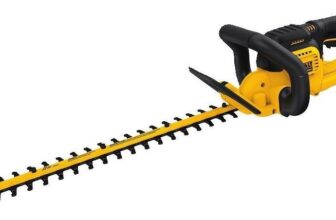
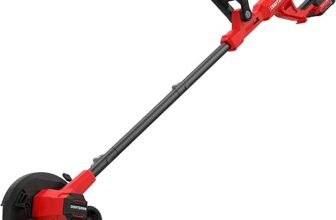
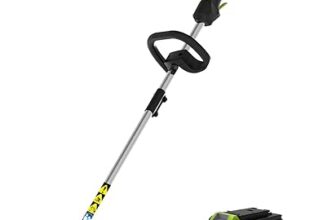
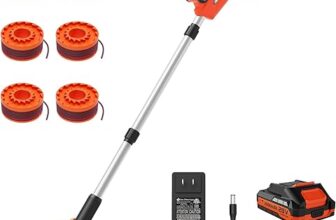

Funny how these comparisons always boil down to: weight vs power. If I only could buy one tool for an apartment garden, which would be less obnoxious noise-wise and easier to store?
Echo for small spaces. The shorter bar helps with storage and it’s more maneuverable around potted plants.
For apartment use, Echo tends to be more compact and perceived as less noisy. Also check local noise ordinances and whether a 20-inch vs 24-inch blade fits your storage space.
Anyone compare fuel mix quirks between them? Heard Husqvarna sometimes prefers a slightly richer mix — what do you all use?
Most modern 2-strokes run fine on a 50:1 mix; follow the manual for the specific model. Some owners briefly favor 40:1 for older machines or running hotter climates, but stick to manufacturer recommendations to avoid warranty issues.
I stick to 50:1 premix (good quality 2-stroke oil) for both. No drama so far.
Wanted to add: maintenance matters. The Husqvarna felt more ‘industrial’ but from my experience, parts and service can be pricier. Echo is a bit simpler to tinker with at home.
True — I had a Husqvarna for ~7 years with regular service. Paid more for parts but it outlived two cheaper models.
I swear by keeping a spare air filter and spark plug. Makes both brands feel like new again 😂
Right — lifetime cost isn’t just initial price. Both brands have solid dealer networks, but parts pricing and DIY-friendliness can vary by model.
Echo’s carb access is nicer, agreed. But Husqvarna’s build sometimes lasts longer if you actually take it for scheduled maintenance.
Okay quick anecdote:
I borrowed a friend’s Husqvarna (that 24-inch model) and tried to trim my boxwoods. It ate through thick stems like butter, but the long blade was awkward around tight corners. Echo would’ve been cleaner for shapes.
So yeah — Husqvarna = brute force, Echo = finesse.
This is super helpful. I’m all about shaping my topiary so Echo might be the one for me.
Great real-world example, Sara. That’s exactly the trade-off many users report: longer bars for big hedges, shorter for sculpting.
Heh I used mine to accidentally shave a rose bush into an abstract sculpture. Finesse was not my friend that day 😅
Not to be that guy, but price is a big factor for me. The review showed them close in price depending on sales. Anybody grabbed a deal recently? I’m hunting Black Friday prices already 😂
Prices fluctuate a lot with promos. Sign up for local dealer newsletters and large retailer alerts — sometimes you can get a Husqvarna with a free tune-up or Echo with accessories thrown in.
I found a used Husqvarna in great shape for half price — if you’re open to used, it’s a great route.
I snagged an Echo on spring clearance last year — saved a couple hundred. Watch for bundle deals.
Small but important: blade sharpening and teeth spacing. The review mentioned Husqvarna’s cut was more aggressive — that also means you might need to file/maintain the blades more often if you hit tough wood.
Not a dealbreaker, just something to note if you hate maintenance.
Excellent point — aggressive cutting can increase wear. We noted that Husqvarna’s blades are also replaceable as a whole, while Echo’s are easier to resharpen at home.
Also check blade coating — some coatings resist sap build-up and reduce cleaning frequency.
I ended up buying a small file kit and it made life easier. Takes 10 mins to keep them snappy.
Great comparison — helped me decide! I liked that the Echo felt lighter in your hands from the review. I do a lot of overhead trimming and that extra ounce (or two) really matters.
Also: anyone else notice the Echo seems quieter in real life than specs suggest? Might be me though 😂
Totally agree. I have an Echo and it definitely feels less tiring for long sessions. Quieter? Maybe — my neighbors still complain 😅
Thanks, Emma — glad it helped! Echo’s body design and muffler tuning often give a slightly lower perceived noise even if dB ratings are similar. Good call on the overhead trimming point.
Longer comment because I had a weird issue someone might relate to:
Bought the Husqvarna mainly for the longer reach. After a month, it started backfiring during cold starts. Dealer said carb needed a tweak. Fixed in 20 mins but I felt dumb for not running it more before purchase.
Lesson: test-start in different temps and get a quick shop check if you’re unsure.
Echo tends to be user-friendly on the choke front. Still, dealer setup is gold for any gas tool.
Same — I always ask for a quick shop startup check when buying new. Worth the time.
Thanks for sharing that — dealers can often spot minor tune issues quickly. Good reminder to test machines under the conditions you’ll use them in.
Does Echo have easier choke systems? I’m terrible at adjusting carbs lol
Short and practical: which one would you recommend for someone with 100 ft of mixed hedges (some thin, some gnarly)? Looking for reliability and decent warranty.
For mixed conditions, many choose Husqvarna for the extra reach and bite on gnarly sections, but Echo shines for finesse and long sessions. Check warranty terms for both in your region — dealer-backed warranties can be more valuable than brand label alone.
I’d go Husqvarna if you have lots of thick stuff, Echo if the job is mostly shaping and light branches.
Humor time: I bought the Husqvarna to impress my in-laws and then spent 2 hours learning how to avoid trimming their prize azaleas into abstract art. Sheesh. 😅
On a serious note — sturdier build, yes, but requires a steady hand.
Pro tip: mark guideline lines with string before cutting. Saved me from ‘creative’ choices.
Love this story — Husqvarna’s power can be a double-edged sword. Maybe practice on an ugly bush first 😂
Been there! First time I used a long bar I created a modern art hedge that my neighbor still mentions.
I appreciate the review’s safety notes. Quick question: are both models OK to use with aftermarket shoulder straps? I feel like Husqvarna’s balance might be better with one.
Both can be used with shoulder straps, but check the attachment points and recommended accessories. Husqvarna’s longer shaft sometimes benefits from a strap for balance; Echo’s lighter unit may not require it but can still be more comfortable with one.
I use a padded strap with Echo and it made a 30% comfort improvement for me.
Been using a Husqvarna blower for years, so I trust the brand. The review made the Husqvarna trimmer sound tempting, but I worry about vibration for my arthritis. Any real-world input?
I have mild joint issues — I went with Echo because of the lighter feel. After 30 mins I felt less strain compared to my neighbor’s Husqvarna.
Brand familiarity is valuable. Husqvarna designs often trade a bit more vibration for raw cutting force, but many models include anti-vibration mounts. If arthritis is a concern, try to test one in-store or look for models with documented AV tech.
Echo is friendlier for long sessions, imo. But if you only trim once a week, Husqvarna’s extra power could finish the job faster and be worth it.